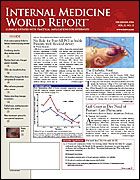Publication
Article
Internal Medicine World Report
Revised AF Guidelines Focus on Stroke Risk as Key to Therapy
Author(s):
Base Anticlotting Therapy on Stroke Risk Rather than Heart Rhythm
J Am Coll Cardiol
Circulation
Eur Heart J
Making every effort to reduce the risk of stroke in patients with atrial fibrillation (AF) and using a patient’s stroke risk to guide decisions about anticoagulation therapy are among the new recommendations in the updated guidelines for the management of AF that reflect a collaborative effort by the American College of Cardiology, American Heart Association, and European Society of Cardiology and published simultaneously in 3 journals (. 2006; 48: 854-906; . 2006; 114:e257-e354; . 2006; 27:1979-2030).
AF currently ranks as the leading heart rhythm disturbance. More than 2 million Americans have been diagnosed with AF, and the condition is expected to become even more prevalent in the coming years as the population ages, the number of patients with chronic heart disease increases, and the techniques used for diagnosis continue to improve. Patients with AF are at increased risk for stroke, heart failure, and all-cause mortality—complications that disproportionately affect women.
The previous guidelines, which were published in 2001, recommended basing decisions about antithrombotic therapy on various patient characteristics—age, gender, risk for heart disease, and comorbidities. The new guidelines recommend using stroke risk (Table 1) as the predominant deciding factor.
“We focused on stroke risk, because atrial fibrillation is associated with increased long-term risk for stroke,” said Valentin Fuster, MD, PhD, of the Mount Sinai Cardiovascular Institute, New York City, who cochaired the guidelines writing committee. “About 15% to 20% of strokes occur in people with atrial fibrillation, and those strokes are especially large and disabling.”
The 2006 guidelines for antithrombotic therapy for patients with AF include a recommendation for daily prophylactic aspirin therapy in those with no stroke risk factors (Table 2). The guidelines also provide simple algorithms to help physicians determine the optimal management for individual patients.
A 3-step approach for prioritizing the objectives of patient care recommends:
• First, control the heart rate
• Next, prevent thromboembolism
• Finally, correct the rhythm disturbance, if possible.
Heart rate control is usually defined by achieving a ventricular rate of 60 to 80 beats/min at rest and of 90 to 115 beats/min during moderate exercise.
The new recommendations indicate that heart rate control is a reasonable therapy for elderly patients with persistent AF who also have hypertension or heart disease. In patients younger than 70 years—especially those with recurrent AF and no underlying heart disease—rhythm control may be better, first using drugs and then catheter ablation if necessary.
But Dr Fuster emphasized, “Regardless of the approach, the need for anticlotting therapy should still be based on stroke risk and not on whether proper heart rhythm is maintained.”
Also new in the 2006 guidelines is that catheter ablation is now considered “a reasonable alternative to drug therapy to treat AF in patients with little or no left atrial enlargement, and in whom drug treatments did not stop the rhythm disturbance,” Dr Fuster said.





